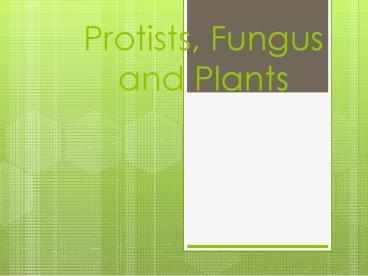Protists, Fungus and Plants PowerPoint PPT Presentation
1 / 20
Title: Protists, Fungus and Plants
1
Protists, Fungus and Plants
2
Kingdom Protista
- All Eukaryotic (Have a nucleus)
- Most are Unicellular, some multicellular
- Classified based on MOVEMENT
- Either Autotrophs and Heterotrophs
- Some have cilia and others have a flagella (used
for movement).
3
Animal-Like Protists
- Classified by the way they move!! Use either
Cilia or Flagella's
4
ZooflagellateTrichonymphia
- Lives in digestive system of termites
- Manufactures cellulase that makes it possible for
termites to digest wood - Mutualistic Relationship with termites, both
BENEFIT!
5
Phylum Sarcodina (Sarcodines)
- Move and feed by cytoplasmic extensions called
pseudopods - Heterotrophic, some parasitic
- Ex Amoebas
6
Phylum Ciliophora (Ciliates)
- Have short hair-like projections called cilia
that are used for movement and feeding - Heterotrophic, some parasitic
7
Plant-Like Protists(aka Algae)
- (Commonly called Algae)
- Contain chlorophyll and carries out photosynthesis
8
Kingdom Fungus
- Are Eukaryotic (have a nucleus), are heterotrophs
and they have cell walls but they do NOT have
chloroplasts.
9
How Fungi Eat
- Fungus do not have mouths so they ABSORB food.
- They are decomposers-Many fungi feed on decaying
organisms.
10
Groups of Fungi
- Common Molds- these include black bread mold
- Sac Fungi- largest group, include yeast, mildew
and truffles. Yeast is used for baking and to
brew beer.
11
Groups of Fungi
- Club Fungi- includes mushrooms and puffballs
- Imperfect Fungi- this fungus helps make
PENICILLIN, an antibiotic used to treat some
bacteria infections.
12
Lichens
- Are organisms that are made up of BOTH fungus and
a green algae. - Algae provide the fungus with energy, the fungus
provides the algae with water and minerals. They
share a mutualistic relationship, where both
benefit.
13
Kingdom Plant
- Multicellular eukaryotes that have cell walls and
chloroplast. - They are autotrophs and make their food through
photosynthesis.
14
What a Plant needs to Survive
- Sunlight, water, minerals, gas exchange,
transport of water and nutrients throughout the
plant body. (stem, leaves, roots) - 1st evolved plant evolved from an organism like
Green Algae.
15
Fill in Cladogram on Notes,
16
Groups of Plants
- Bryophytes- depend on water for reproduction,
lack vascular tissue, draw up water through
osmosis Examples Mosses - Seedless Vascular Plants- can move fluids through
the plant body against gravity using xylem
(brings water up) and phloem(sends nutrients to
the leaves) ex Ferns
17
Groups of Plants
- Gymnosperms- reproduce with seeds that are
exposed, means naked seed. ExConifers - Angiosperms- have seed too, but they have flowers
or fruits that holds the seeds. Ex Roses - Flowers attract insects to help pollinate the
plant and to help spread seeds to others plants. - Fruit- is the ovary of the plant/tree that
protects the seeds.
18
Root Types (anchors plants)
- Taproot- long and thick with secondary small
roots.
- Fibrous Root- no single root
19
Leaf Function
- System that specializes in Photosynthesis (making
food from sunlight), Transpiration (loss of
water) and Gas Exchange (taking in carbon dioxide
and releasing oxygen. - Plants keep their Stoma open just enough to allow
photosynthesis but not enough to lose excessive
amounts of water. A lot of times they close at
night or even close under really hot and dry
conditions.
20
Stem Function
- Support for and the elevation of leaves, flowers
and fruits. - The stems keep the leaves in the light and
provide a place for the plant to keep its flowers
and fruits. - Transport of fluids between the roots and the
leaves using the xylem and phloem inside the
stem. - Storage of nutrients

